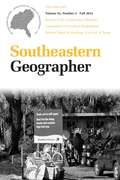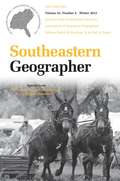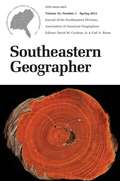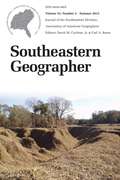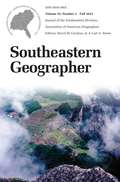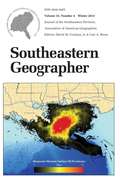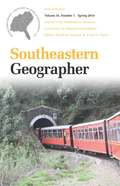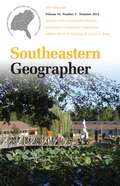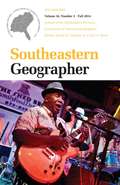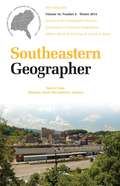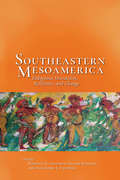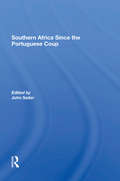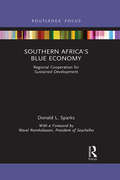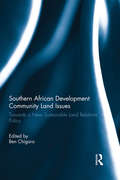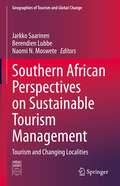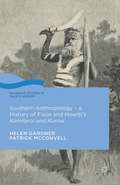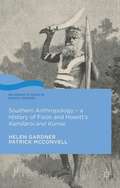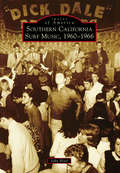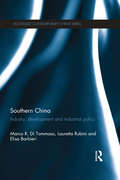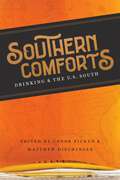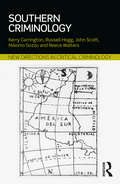- Table View
- List View
Southeastern Geographer, Volume 52, #3 (Fall #2012)
by Carl A. Reese David M. CochranTable of Contents for Volume 52, Number 3 (Fall 2012)<P><P> Cover Art<P> Co-producing Space Along the Sweetgrass Basket Makers' Highway in Mount Pleasant, South Carolina <P> Brian Grabbatin<P><P> Introduction <P> David M. Cochran, Jr. and Carl A. Reese<P><P> Part I: Papers<P><P> Pet Ownership and the Spatial and Temporal Dimensions of Evacuation Decisions <P> Courtney N. Thompson, David M. Brommer, and Kathleen Sherman-Morris<P><P> Salinity Assessment in Northeast Florida Bay Using Landsat TM Data <P> Caiyun Zhang, Zhixiao Xie, Charles Roberts, Leonard Berry, and Ge Chen<P><P> An Assessment of Human Vulnerability to Hazards in the US Coastal Northeast and mid-Atlantic <P> Shivangi Prasad<P><P> Black, White or Green?: The Confederate Battle Emblem and the 2001 Mississippi State Flag Referendum <P> Jonathan I. Leib and Gerald R. Webster<P><P> The Role of Landscape in the Distribution of Deer-Vehicle Collisions in South Mississippi <P> Jacob J. McKee and David M. Cochran, Jr.<P><P> Part II: Geographical Notes<P><P> Dr. John J. Winberry, Jr. (1945–2012) <P> Gregory J. Carbone<P> Part III: Reviews<P><P> Removing Mountains: Extracting Nature and Identity in the Appalachian Coalfields <P> Rebecca R. Scott<P> Reviewed by Sarah A. Watson<P><P> Mobile Urbanism: Cities and Policymaking in the Global Age <P> Eugene McCann and Kevin Ward, eds.<P> Reviewed by Brian K. Blickenstaff
Southeastern Geographer, Volume 52, #4 (Winter #2012)
by Carl A. Reese David M. CochranTable of Contents for Volume 52, Number 4 (Winter 2012)<P><P> Special Issue: Placing Memory and Heritage in the Geography Classroom<P> Guest Editor: Chris W. Post<P><P> Cover Art<P> The Mule Pull at the Mississippi Pecan Festival <P> Joseph S. Miller<P><P> Introduction: Placing Memory and Heritage in the Geography Classroom <P> Chris W. Post<P><P> Part I: Papers<P><P> ''History by the Spoonful'' in North Carolina: The Textual Politics of State Highway Historical Markers <P> Derek H. Alderman<P><P> Remembrance and Place-Making: Teaching Students to Look Ahead While Looking Back <P> Stephen S. Birdsall<P><P> Editing Memory and Automobility & Race: Two Learning Activities on Contested Heritage and Place <P> Kenneth E. Foote <P><P> A Tale of Two Civil War Statues: Teaching the Geographies of Memory and Heritage in Norfolk, Virginia <P> Jonathan I. Leib<P><P> Objectives and Prospects for Bringing Service-Learning into the Memory and Heritage Classroom <P> Chris W. Post<P><P> Making Memory, Making Landscapes: Classroom Applications of Parallel Trends in the Study of Landscape, Memory, and Learning <P> Owen J. Dwyer and Matthew McCourt<P><P> Part II: Geographical Notes<P><P> A Tribute to Dr. Louis De Vorsey, Jr. (1929–2012) <P> Sanford H. Bederman<P> Part III: Reviews<P><P> From Chicaza to Chickasaw: The European Invasion and the Transformation of the Mississippian World, 1540–1715 <P> Robbie Ethridge<P> Reviewed by Craig S. Revels<P><P> Key Methods in Geography <P> Nicholas Clifford, Shaun French, and Gill Valentine (Editors)<P> Reviewed by Bandana Kar
Southeastern Geographer, Volume 53, #1 (Spring #2013)
by Carl A. Reese David M. CochranTable of Contents for Volume 53, Number 1 (Spring 2013)<P><P> Cover Art<P> Tropical Tree Rings and Environmental Change <P> Grant L. Harley<P><P> Introduction to Southeastern Geographer, Volume 53, Number 1<P> Carl A. Reese and David M. Cochran<P><P> Part I: Papers<P><P> Gasoline Station Morphology on Virginia's Eastern Shore<P> Bradley D. Macpherson and Mark de Socio<P><P> Six Decades (1948–2007) of Landscape Change in the Dougherty Plain of Southwest Georgia, USA <P> Glenn I. Martin, Jeffrey Hepinstall-Cymerman, and L.Katherine Kirkman<P><P> Solar Cycle Extremes as a Seasonal Predictor of Atlantic-Basic Tropical Cyclones <P> Brian T. Hutton, Jr., Kelsey N. Scheitlin, and P. Grady Dixon<P><P> Impact of Prescribed Burns on Marsh Surface Elevation: Big Branch Marsh, Louisiana <P> Christopher M. Henton, Carl A. ''Andy'' Reese, Franklin T. Heitmuller,and John Andrew S. Fleming <P><P> Assessing Potential Urban Tree Planting Sites in the Piedmont of the United States: A Comparison of Methods <P> Krista Merry, Jacek Siry, Pete Bettinger, and J. M. Bowker<P><P> Making Sense of the Strip: The Postmodern Pastiche of Pigeon Forge, Tennessee <P> Ann Fletchall<P><P> Part II: Reviews<P><P> The Canal Builders: Making America's Empire at the Panama Canal <P> Julie Greene<P> Reviewed by Ashley D. Carse <P><P> Green Metropolis: Why Living Smaller, Living Closer, and Driving Less are the Keys to Sustainability <P> David Owen<P> Reviewed by Matthew Fry
Southeastern Geographer, Volume 53, #2 (Summer #2013)
by Carl A. Reese David M. CochranTable of Contents for Volume 53, Number 2 (Summer 2013) Cover Art Sleeping Kudzu J. O. Joby Bass Introduction to Southeastern Geographer, Volume 53, Number 2 <P><P> David M. Cochran and Carl A. Reese<P><P> Part I: Papers<P><P> Recovering Destination from Devastation: Tourism, Image, and Economy Along the Hurricane Coasts<P> Ronald L. Schumann, III<P><P> Foreign-born Latino Labor Market Concentration in Six Metropolitan Areas in the U.S. South <P> Sara Gleave and Qingfang Wang<P><P> Downstream Trends in Grain Size, Angularity, and Sorting of Channel-Bed and Bank Deposits in a Coastal Plain Sand-Bed River: the Pascagoula River System, Mississippi, USA <P> Zachary A. Musselman and Allison M. Tarbox<P><P> Displacement and the Racial State in Olympic Atlanta, 1990–1996 <P> Seth Gustafson<P><P> Pentagon Contracts and Dixie <P> Barney Warf<P><P> Part II: Reviews<P><P> Swamplife: People, Gators, and Mangroves Entangled in the Everglades <P> Laura A. Ogden<P> Reviewed by Scott H. Markwith<P><P> Cahokia: Ancient America's Great City on the Mississippi <P> Timothy R. Pauketat<P> Reviewed by William I. Woods
Southeastern Geographer, Volume 53, #3 (Fall #2013)
by Carl A. Reese David M. CochranTable of Contents for Volume 53, Number 3 (Fall 2013)<P><P> COVER ART<P> The View from Huayna Picchu <P> Carl A. Reese <P><P> Introduction to Southeastern Geographer, Volume 53, Number 3 <P> David M. Cochran and Carl A. Reese <P><P> PART I: PAPERS <P><P> High Temporal Resolution Land Use/ Land Cover Change from 1984 to 2010 of the Little River Watershed, Tennessee, Investigated Using Landsat and Google Earth Images <P> Chunhao Zhu and Yingkui Li <P><P> Look Away, Look Away, Look Away to Lexington: Struggles over Neo-Confederate Nationalism, Memory, and Masculinity in a Small Virginia Town <P> Jon D. Bohland <P><P> Web-Based Geospatial Technology Tools for Metropolitan Planning Organizations <P> Rakesh Malhotra, Gurmeet Virk, Felix Nwoko, and Amanda Klepper <P><P> Spatial and Temporal Patterns of an Ethnic Economy in a Suburban Landscape of the Nuevo South <P> Nancy Hoalst-Pullen, Vanessa Slinger-Friedman, Harold R. Trendell, and Mark W. Patterson <P><P> Toward a Publicly Engaged Geography: Polycentric and Iterated Research <P> Jennifer F. Brewer<P><P> PART II: REVIEWS <P><P> Longleaf, Far as the Eye Can See: A New Vision of North America's Richest Forest <P> Bill Finch, Beth Maynor Young, Rhett Johnson, and John C. Hall <P> Reviewed by Grant L. Harley<P><P> The Land Was Ours: African American Beaches from Jim Crow to the Sunbelt South <P> Andrew W. Kahrl <P> Reviewed by Heather Ward
Southeastern Geographer, Volume 53, #4 (Winter #2013)
by Carl A. Reese David M. CochranSoutheastern Geographer is published by UNC Press for the Southeastern Division of the Association of American Geographers (www.sedaag.org). The quarterly journal publishes the academic work of geographers and other social and physical scientists, and features peer-reviewed articles and essays that reflect sound scholarship and contain significant contributions to geographical understanding, with a special interest in work that focuses on the southeastern United States.
Southeastern Geographer, Volume 54, #1 (Spring #2014)
by Carl A. Reese David M. CochranSoutheastern Geographer<P> VOLUME 54, NUMBER 1 : SPRING 2014<P><P> Table of Contents<P><P> Introduction to Southeastern Geographer, Volume 54, Number 1<P> David M. Cochran and Carl A. Reese<P> Part I: Papers<P><P> The Great Lakes-to-Florida Highway: A Politics of Road Space in 1920s West Virginia and Virginia <P> Jessey Gilley<P><P> Do Incentives Work? An Analysis of Residential Solar Energy Adoption in Miami-Dade County, Florida<P> Jeffery Onsted and Aileen Varela-Margolles<P><P> Disaster Vulnerability of Migrant and Seasonal Farmworkers: A Comparison of Texas and North Carolina <P> Christine E. Gares and Burrell E. Montz<P><P> Louisiana: Apprehending a Complex Web of Vernacular Regional Geography <P> John McEwen<P><P> Spatial Trends and Factors Associated with Hardwood Mortality in the Southeastern United States<P> Michael Crosby, Zhaofei Fan, Theodor D. Leninger, Martin A. Spetich and A. Brady Self<P><P> Part II: Reviews<P><P> The Geography of Wine: How Landscapes, Cultures, Terror, and the Weather Make a Good Drop<P> Brian J. Sommers<P> Reviewed by David M. Cochran, Jr.<P><P> Dear Appalachia: Readers, Identity, and Popular Fiction since 1878<P> Emily Satterwhite<P> Reviewed by Taulby H. Edmondson<P><P> Trash Animals: How We Live with Nature's Filthy, Feral, Invasive, and Unwanted Species <P> Kelsi Nagy and David Johnson II<P> Reviewed by Matthew L. Fahrenbruch<P><P> Southeastern Geographer is published by UNC Press for the Southeastern Division of the Association of American Geographers (www.sedaag.org). The quarterly journal publishes the academic work of geographers and other social and physical scientists, and features peer-reviewed articles and essays that reflect sound scholarship and contain significant contributions to geographical understanding, with a special interest in work that focuses on the southeastern United States.
Southeastern Geographer, Volume 54, #2 (Summer #2014)
by Carl A. Reese David M. CochranSoutheastern Geographer <P> VOLUME 54, NUMBER 2 : SUMMER 2014 <P> Table of Contents <P><P> Cover Art The Buddha Abides in Mississippi Mark M. Miller <P> Introduction to Southeastern Geographer, Volume 54, Number 2 Carl A. Reese and David M. Cochran <P><P> Part I: Papers <P><P> The Geography of Non-Earned Income in the Piedmont Megapolitan Cluster Keith G. Debbage, Bradley Bereitschaft, and Edward Beaver <P><P> Challenges and Opportunities for Southeast Agriculture in a Changing Climate: Perspectives from State Climatologists Pam Knox, Chris Fuhrmann, and Chip Konrad<P><P> Peoples' Perceptions of Housing Market Elements in Knoxville, Tennessee Madhuri Sharma <P><P> Structure and Dynamics of an Old-Growth Pine-Oak Community in the Southern Appalachian Mountains, Georgia, U.S.A. Christopher A. Petruccelli, John Sakulich, Grant L. Harley, and Henri D. Grissino-Mayer <P><P> "A Tale of Mice and Men": The WPA, the LSU Indian Room Museum, and the Emergence of Professional Archaeology in the U.S. South Amy E. Potter, Dydia DeLyser, and Rebecca Saunders <P><P> Part II: Reviews <P><P> Drive: A Road Trip Through our Complicated Affair with the Automobile Tim Falconer Reviewed by Dawn M. Drake <P><P> Fields and Streams: Stream Restoration, Neoliberalism, and the Future of Environmental Science Rebecca Lave Reviewed by Eric Nost <P><P> Southeastern Geographer is published by UNC Press for the Southeastern Division of the Association of American Geographers (www.sedaag.org). The quarterly journal publishes the academic work of geographers and other social and physical scientists, and features peer-reviewed articles and essays that reflect sound scholarship and contain significant contributions to geographical understanding, with a special interest in work that focuses on the southeastern United States.
Southeastern Geographer, Volume 54, #3 (Fall #2014)
by Carl A. Reese David M. CochranSoutheastern Geographer is published by UNC Press for the Southeastern Division of the Association of American Geographers (www.sedaag.org). The quarterly journal publishes the academic work of geographers and other social and physical scientists, and features peer-reviewed articles and essays that reflect sound scholarship and contain significant contributions to geographical understanding, with a special interest in work that focuses on the southeastern United States.
Southeastern Geographer, Volume 54, #4 (Winter #2014)
by Carl A. Reese David M. CochranSoutheastern Geographer is published by UNC Press for the Southeastern Division of the Association of American Geographers (www.sedaag.org). The quarterly journal publishes the academic work of geographers and other social and physical scientists, and features peer-reviewed articles and essays that reflect sound scholarship and contain significant contributions to geographical understanding, with a special interest in work that focuses on the southeastern United States.
Southeastern Mesoamerica: Indigenous Interaction, Resilience, and Change
by Whitney A. Goodwin Erlend Johnson Alejandro J. FigueroaSoutheastern Mesoamerica highlights the diversity and dynamism of the Indigenous groups that inhabited and continue to inhabit the borders of Southeastern Mesoamerica, an area that includes parts of present-day Honduras, Guatemala, and El Salvador. Chapters combine archaeological, ethnohistoric, and historic data and approaches to better understand the long-term sociopolitical and cultural changes that occurred throughout the entirety of human occupation of this area. Drawing on archaeological evidence ranging back to the late Pleistocene as well as extensive documentation from the historic period, contributors show how Southeastern Mesoamericans created unique identities, strategically incorporating cosmopolitan influences from cultures to the north and south with their own long-lived traditions. These populations developed autochthonous forms of monumental architecture and routes and methods of exchange and had distinct social, cultural, political, and economic traits. They also established unique long-term human-environment relations that were the result of internal creativity and inspiration influenced by local social and natural trajectories. Southeastern Mesoamerica calls upon archaeologists, anthropologists, historians, ethnohistorians, and others working in Mesoamerica, Central America, and other cultural boundaries around the world to reexamine the role Indigenous resilience and agency play in these areas and in the cultural developments and interactions that occur within them. Contributors: Edy Barrios, Christopher Begley, Walter Burgos, Mauricio Díaz García, William R. Fowler, Rosemary A. Joyce, Gloria Lara-Pinto, Eva L. Martínez, William J. McFarlane, Cameron L. McNeil, Lorena D. Mihok, Pastor Rodolfo Gómez Zúñiga, Timothy Scheffler, Edward Schortman, Russell Sheptak, Miranda Suri, Patricia Urban, Antolín Velásquez, E. Christian Wells
Southern Africa Since The Portuguese Coup
by John SeilerFirst published in 1980. Toward the end of 1975 the author decided to edit a collection of essays on political developments in Southern Africa. Regional events since the Portuguese coup in April 1974 had already made an enormous impact, first suggesting the possibilities of peaceful accommodation between South Africa and its neighbors, but then demonstrating the destructive impact in Angola of widespread international intervention (in the latter half of 1975). From 1975 to the present, events in Southern Africa have neared center stage in international attention, but, as these essays will show, outstanding regional differences are no closer to peaceful resolution in late 1979 than they were in early 1976.
Southern Africa's Blue Economy: Regional Cooperation for Sustained Development (Europa Introduction to...)
by Donald L. SparksSouthern Africa’s maritime interests are considerable: its oceans and ports are essential to the wealth of the region, are crucial for trade and are an important source of employment, food and energy. However, regional governments do not place sufficient attention on the Blue Economy and its potential to stimulate economic growth. Of the 17 UN Sustainable Development Goals, goal Number 14 (Life Below Water) is the least funded. Less than 1% of Official Development Assistance goes toward this goal, and even private investment and funding from philanthropic organizations is grossly inadequate to meet Africa’s blue economy needs. It is vital for the international community to face up to the challenges of Africa’s Blue Economy and start working on solutions and for southern Africa’s Blue Economy policies and goals to be expanded. Just as sustainable development green initiatives show promise, so too could Blue Economy projects and activities. Southern Africa’s rich coastal and marine resources need to be managed on both a national and regional level if they are to be used in a long-term, sustainable way. This book provides, for the first time, a concise study of the constraints and opportunities that the Blue Economy offers for southern Africa and the role that the Southern African Development Community (SADC) could play in fostering a sustainable use of its ocean and coastal resources.
Southern African Development Community Land Issues: Towards a New Sustainable Land Relations Policy
by Ben ChigaraThis book constitutes volume one of a two volume examination of development community land issues in Southern Africa. In this volume, Ben Chigara undertakes a holistic inter-disciplinary evaluation of the legitimacy of colonial and emergent post-colonial rule property rights in affected States of the Southern African Development Community (SADC). It particularly focuses on intensifying litigation in national courts, the SADC Tribunal, and more recently the Washington based International Centre for the Settlement of Investment Disputes (ICSID) regarding counter claims to title to property. The book examines cultural, economic and political drivers at the core of SADC land issues, focusing on their significance and potential to contribute to the discovery of a new, sustainable land relations policy that guarantees social justice in the distribution of all the advantages and disadvantages relating to the allocation and use of land. Chigara shows that persistent systematic administrative failures by pre-colonial, colonial and post-colonial authorities have made for a very complex challenge that requires Solomonic tools that neither the Courts alone, nor human rights centric morality alone could resolutely attend. The book recommends a sophisticated systematic new approach to SADC land issues, which is developed in volume two, Re-conceiving Property Rights in the New Millennium. This book will be of great interest to students and researchers of Property and Conveyancing Law, Human Rights Law and Land Law.
Southern African Perspectives on Sustainable Tourism Management: Tourism and Changing Localities (Geographies of Tourism and Global Change)
by Jarkko Saarinen Berendien Lubbe Naomi N. MosweteThis edited collection focuses on tourism development, sustainability and local change in southern Africa. The book offers a range of both conceptual and applied perspectives that address various changes in southern African tourism and community development relations. The key drivers of change that include climate change and globalization form the context for the diverse and interesting set of case studies from the region. The main conceptual grounds of the book cover sustainability, sustainable development goals (SDGs), responsibility, vulnerability, adaptation, resilience, governance, local development and inclusive growth. In this book sustainability is seen as one of the most important issues currently facing the tourism sector, affecting all types and scales of tourism operations and environments in the region. Tourism is an increasingly important economy in the southern African region and the industry is creating changes for communities and environment while also facing major challenges caused by global trends and changes. The book offers a case study driven approach to sustainability needs of tourism development in local community contexts. The case study chapters are linked through the book’s focus on sustainable tourism and local community development. Through emphasizing the need to understand both global change and local contexts in sustainable tourism development, this book is a valuable resource for all those working in the field.
Southern Anthropology - a History of Fison and Howitt’s Kamilaroi and Kurnai: A History Of Fison And Howitt's Kamilaroi And Kurnai (Palgrave Studies in Pacific History)
by Helen Gardner Patrick McConvellSouthern Anthropology, the history of Fison and Howitt's Kamilaroi and Kurnai is the biography of Kamilaroi and Kurnai (1880) written from both a historical and anthropological perspective. Southern Anthropology investigates the authors' work on Aboriginal and Pacific people and the reception of their book in metropolitan centres.
Southern Anthropology – a History of Fison and Howitt’s Kamilaroi and Kurnai (Palgrave Studies In Pacific History)
by Helen Gardner Patrick McConvellSouthern Anthropology, the history of Fison and Howitt's Kamilaroi and Kurnai is the biography of Kamilaroi and Kurnai (1880) written from both a historical and anthropological perspective. Southern Anthropology investigates the authors' work on Aboriginal and Pacific people and the reception of their book in metropolitan centres.
Southern Arabia (Folios Archive Library)
by BentFirst published in 2005. Routledge is an imprint of Taylor & Francis, an informa company.
Southern Asia, Australia and the Search for Human Origins
by Robin Dennell Martin PorrThis is the first book to focus on the role of Southern Asia and Australia in our understanding of modern human origins and the expansion of Homo sapiens between East Africa and Australia before 30,000 years ago. With contributions from leading experts that take into account the latest archaeological evidence from India and Southeast Asia, this volume critically reviews current models of the timing and character of the spread of modern humans out of Africa. It also demonstrates that the evidence from Australasia should receive much wider and more serious consideration in its own right if we want to understand how our species achieved its global distribution. Critically examining the 'Out of Africa' model, this book emphasises the context and variability of the global evidence in the search for human origins.
Southern California Surf Music, 1960-1966
by John BlairDick Dale & the Del-Tones began holding weekend dances at the Rendezvous Ballroom in Balboa, California, in the summer of 1960. Over the next year and a half, Dale developed the sound and style that came to be known as "surf music." The result was the development of more powerful guitar amplifiers, a dramatic increase in the sales of Fender guitars and amplifiers, and a shift from New York to West Coast recording studios. More and more people were drawn to the sport of surfing, which became an important part of teen beach culture at the time. Even landlocked teenagers were captured by the moment, carrying surfboards atop their woodies in Phoenix or bleaching their hair blonde in St. Paul. For hundreds of thousands of kids, though, the attraction was not the connection to surfing; it was the connection to the music pioneered by Dick Dale.
Southern China: Industry, Development and Industrial Policy (Routledge Contemporary China Series)
by Marco R. Di Tommaso Lauretta Rubini Elisa BarbieriBy concentrating on one of the key locations of global manufacturing, this volume offers a contribution to contemporary industry studies. The rates of growth that have characterized the southern Guangdong province in the last three decades are unique, even with respect to the more general and often cited Chinese experience. But what role have governments played in these decades of growth? What are the aims and tools of industrial policies promoted in this core location of contemporary manufacturing? And what are the implications of the Guangdong experience of growth for the international debate on contemporary industry? Referencing the international debate on industrial development, specialized Chinese academic literature, official government documents, statistics and in-depth fieldwork this book offers unique view on the complex set of long-term national and local government plans and policies that have gone hand in hand with the last three decades of impressive change in this highly industrialized region. In this framework, local industrial development policy, innovation policy and migration policy are carefully analyzed as three of the main strategic interventions selected by government authorities to promote the desired gradual structural change and technological upgrading in industry. This book will be of interest to students and scholars of Chinese studies, economics and business, development policy and industrial policy. Furthermore, the volume presents stimulating material for both policy makers and entrepreneurs.
Southern Comforts: Drinking and the U.S. South (Southern Literary Studies)
by J. Gerald Kennedy Monica Carol Miller Susan Zieger Scott Romine Jerod Ra'Del Hollyfield Katharine Burnett Zackary Vernon David A. Davis Matthew Sutton Alison Arant John Stromski Cara Koehler Caleb Doan Ellen Lansky Jenna Sciuto Christopher Rieger Robert Rea Hannah C. Griggs Jennie Lightweis-GoffMoving beyond familiar myths about moonshiners, bootleggers, and hard-drinking writers, Southern Comforts explores how alcohol and drinking helped shape the literature and culture of the U.S. South. Edited by Conor Picken and Matthew Dischinger, this collection of seventeen thought-provoking essays proposes that discussions about drinking in southern culture often orbit around familiar figures and mythologies that obscure what alcohol consumption has meant over time. Complexities of race, class, and gender remain hidden amid familiar images, catchy slogans, and convenient stories. As the first collection of scholarship that investigates the relationship between drinking and the South, Southern Comforts challenges popular assumptions by examining evocative topics drawn from literature, music, film, city life, and cocktail culture. Taken together, the essays collected here illustrate that exaggerated representations of drinking oversimplify the South’s relationship to alcohol, in effect absorbing it into narratives of southern exceptionalism that persist to this day. From Edgar Allan Poe to Richard Wright, Bessie Smith to Johnny Cash, Bourbon Street tourism to post-Katrina disaster capitalism and more, Southern Comforts: Drinking and the U.S. South uncovers the reciprocal relationship between mythologies of drinking and mythologies of region.
Southern Criminology (New Directions in Critical Criminology)
by John Scott Kerry Carrington Reece Walters Russell Hogg Máximo SozzoCriminology has focused mainly on problems of crime and violence in the large population centres of the Global North to the exclusion of the global countryside, peripheries and antipodes. Southern criminology is an innovative new approach that seeks to correct this bias. This book turns the origin stories of criminology, which simply assumed a global universality, on their head. It draws on a range of case studies to illustrate this point: tracing criminology’s long fascination with dangerous masculinities back to Lombroso’s theory of atavism, itself based on an orientalist interpretation of men of colour from the Global South; uncovering criminology’s colonial legacy, perhaps best exemplified by the over-representation of Indigenous peoples in settler societies drawn into the criminal justice system; analysing the ways in which the sociology of punishment literature has also been based on Northern theories, which assume that forms of penalty roll out from the Global North to the rest of the world; and making the case that the harmful effects of eco-crimes and global warming are impacting more significantly on the Global South. The book also explores how the coloniality of gender shapes patterns of violence in the Global South. Southern criminology is not a new sub-discipline within criminology, but rather a journey toward cognitive justice. It promotes a perspective that aims to invent methods and concepts that bridge global divides and enhance the democratisation of knowledge, more befitting of global criminology in the twenty-first century.
Southern Cultures: Southern Lives Issue
by Harry L. Watson Jocelyn NealIn this special Southern Lives issue:* Billy Carter dresses for all occasions.* Virginia Foster Durr opens her home to recently released inmates.* Michael McFee tours the Billy Graham Library.* Septima Poinsette Clark celebrates fellow Civil Rights pioneers.* Albert Murray goes on the record about Ralph Ellison's style.* Margaret Walker Alexander reveals her takes on Langston Hughes, Toni Morrison, and Alice Walker.... and much more.Southern Cultures is published quarterly (spring, summer, fall, winter) by the University of North Carolina Press. The journal is sponsored by the University of North Carolina at Chapel Hill's Center for the Study of the American South.
Southern Decadence in New Orleans
by Howard Philips Smith Frank PerezFounded in the summer of 1972 by a few friends as a modest celebration, the Southern Decadence festival has since grown into one of New Orleans’s largest annual tourist events.The multiday extravaganza features street parties, drag contests, dancing, drinking, and bead tosses, culminating with a boisterous parade through the French Quarter. With over 200,000 participants—predominantly LGBT+—these unbridled, pre–Labor Day festivities now generate millions of dollars in revenue.Howard Philips Smith and Frank Perez’s Southern Decadence in New Orleans brings together an astounding array of materials to provide the first comprehensive, historical look at Southern Decadence. In an engaging account spanning five decades, the authors combine a trove of rare memorabilia from the event’s founders, early photographs and film stills, newspaper and magazine articles, interviews with longtime participants, a list of all the parades and grand marshals, as well as reproductions of early Southern Decadence invitations. Throughout, the authors explore the pivotal moments and public perceptions related to the festival—including the myths and conjecture that often inaccurately characterized it—and provide an in-depth narrative detailing how a small party in the Faubourg Tremé grew into a worldwide destination predominantly for gay men.Lauded by city leaders as the second-most profitable festival in New Orleans (outshone only by Mardi Gras), Southern Decadence emanates an air of frivolity that masks its enormous impact on the culture and economy of the Crescent City. But with such growth comes the challenge of maintaining the original spirit of camaraderie while managing expanding administrative and logistical responsibilities. Southern Decadence in New Orleans serves as a historical record that helps ensure the future of the celebration remains forever linked to the joyous impulse of its humble beginnings.
